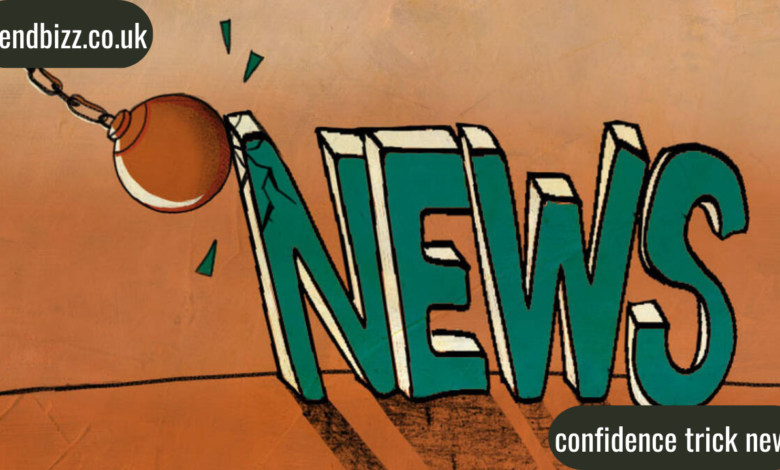Confidence Trick News: Understanding the Deceptive World of Fake and Manipulative News

Introduction to Confidence Trick News
In today’s digital age, information travels faster than ever. While this rapid flow of news has its benefits, it also comes with a significant drawback: the rise of confidence trick news. This type of news refers to deceptive, misleading, or fabricated information designed to manipulate public perception, influence opinions, or achieve hidden agendas. Unlike simple misinformation, confidence trick news is crafted with the intent to deceive, often employing psychological tactics to appear credible and trustworthy.
Understanding how confidence trick news operates is crucial for anyone who consumes online content. Whether it appears on social media, news websites, or in forwarded messages, being able to recognize and combat this form of deception is an essential skill in the modern world.
The Psychology Behind Confidence Trick News
Confidence trick news exploits fundamental aspects of human psychology. It preys on emotions, biases, and cognitive shortcuts that shape how we perceive information. Some of the primary psychological tactics used include:
- Emotional Manipulation: Sensational headlines and exaggerated claims evoke strong emotional responses, making people more likely to believe and share the news without verification.
- Confirmation Bias: People tend to believe information that aligns with their existing beliefs, making them more susceptible to news that reinforces their viewpoints.
- Authority and Credibility Illusion: Fake news often presents itself as coming from credible sources, using official-looking websites, professional writing styles, or fabricated expert quotes.
- Social Proof and Virality: If a news piece is widely shared or commented on, people assume it must be true, even if it’s entirely fabricated.
These psychological triggers make confidence trick news highly effective, spreading misinformation and influencing opinions on a massive scale.
How Confidence Trick News Spreads
Confidence trick news is not limited to obscure corners of the internet. It often finds its way onto major social media platforms, news aggregators, and even mainstream media. The most common channels through which it spreads include:
- Social Media Platforms: Facebook, Twitter, Instagram, and WhatsApp are major breeding grounds for confidence trick news due to their ability to quickly share content.
- Clickbait Websites: Some websites generate misleading articles solely for clicks and advertising revenue, often distorting real events to attract traffic.
- Manipulated Videos and Images: Deepfakes, edited images, and misleading video clips can create entirely false narratives that appear authentic.
- Anonymous Sources and Fake Profiles: Online trolls, bots, and fake accounts often spread deceptive news under the guise of whistleblowers or concerned citizens.
- Political and Ideological Propaganda: Governments, organizations, and interest groups sometimes spread confidence trick news to sway public opinion and achieve specific political or financial goals.
Real-World Examples of Confidence Trick News
Confidence trick news has played a significant role in various historical and political events. Some well-known examples include:
- Election Manipulation: Fake news stories circulated during elections have been proven to influence voter behavior and create political division.
- Health Misinformation: The spread of false medical advice, such as fake COVID-19 cures, has caused widespread harm and even fatalities.
- Financial Scams: Fake news about stock markets, cryptocurrencies, and business scandals have manipulated markets and led to significant financial losses.
- Celebrity Death Hoaxes: False reports about celebrity deaths often trend on social media, misleading millions before they are debunked.
Each of these cases highlights the power and danger of confidence trick news, emphasizing the need for vigilance in media consumption.
How to Spot Confidence Trick News
Detecting confidence trick news requires critical thinking and fact-checking. Here are some key strategies to identify and avoid falling victim to deceptive news:
- Check the Source: Verify if the news comes from a reputable media outlet. Be wary of obscure websites with no credible background.
- Analyze the Headline: Sensational or exaggerated headlines are often a sign of fake news designed to attract clicks.
- Look for Supporting Evidence: Reliable news reports cite multiple credible sources. If a story lacks references or links to verifiable information, it’s likely unreliable.
- Reverse Image Search: If an article features an image, use tools like Google Reverse Image Search to check its authenticity.
- Cross-Check Information: Compare the news with reports from other reputable sources to confirm its accuracy.
- Beware of Emotional Manipulation: If a piece of news evokes extreme anger, fear, or joy, take a step back and critically evaluate its claims.
- Investigate the Author: If the author’s identity or credentials are unclear, be skeptical of their credibility.
The Impact of Confidence Trick News on Society
The widespread influence of confidence trick news poses significant dangers to society. Some of the major consequences include:
- Erosion of Trust in Media: As fake news becomes more common, people start distrusting even credible news sources, leading to widespread skepticism and confusion.
- Political Polarization: Deceptive news stories fuel division, creating hostility and misinformation-driven conflicts.
- Public Health Risks: False medical information can lead to harmful practices, such as avoiding vaccinations or using ineffective treatments.
- Economic Consequences: Financial misinformation can drive panic in stock markets, affect consumer behavior, and lead to business losses.
Addressing these consequences requires collective efforts from individuals, media organizations, and governments to combat misinformation effectively.
Combating Confidence Trick News
Fighting confidence trick news is a responsibility that falls on both content consumers and creators. Here are some ways to contribute to the fight against misinformation:
- Educate Yourself and Others: Stay informed about media literacy and share knowledge on identifying fake news.
- Report Fake News: Most social media platforms allow users to report misleading content.
- Encourage Critical Thinking: Promote discussions that question and verify news rather than accepting it blindly.
- Support Fact-Checking Initiatives: Organizations like Snopes and FactCheck.org work to debunk false news and provide accurate information.
- Be a Responsible Sharer: Before sharing news, verify its authenticity to prevent the spread of misinformation.
Conclusion
Confidence trick news is a growing menace that thrives on deception and manipulation. With its ability to shape opinions, influence elections, and even put lives at risk, combating this form of fake news is crucial. By developing a skeptical mindset, employing fact-checking techniques, and encouraging responsible media consumption, individuals can help reduce the spread of confidence trick news and contribute to a more informed society.
FAQs About Confidence Trick News
Q1: How does confidence trick news differ from misinformation?
A1: Misinformation refers to false or inaccurate information shared without intent to deceive, while confidence trick news is deliberately crafted to mislead and manipulate audiences.
Q2: Can confidence trick news be accidental?
A2: While some misinformation spreads unintentionally, confidence trick news is usually created with the purpose of deceiving for personal, political, or financial gain.
Q3: Why do people fall for confidence trick news?
A3: People often fall for it due to psychological biases, emotional manipulation, and the credibility illusion created by deceptive sources.
Q4: How can social media companies prevent confidence trick news?
A4: They can implement stricter content moderation, promote fact-checking, and educate users on identifying fake news.
By staying vigilant and questioning the reliability of the news we consume, we can collectively combat the dangers of confidence trick news and foster a more truthful information landscape.




